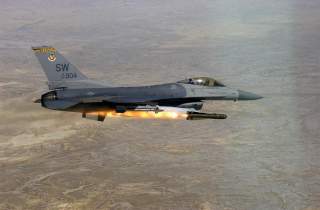Asia's 5 Most Lethal Wars of All Time
"Today, Asia is in one of its most peaceful periods in modern history...It hasn’t always been this way."
Today, Asia is in one of its most peaceful periods in modern history. All current political posturing aside, Asia today is a peaceful place where economic growth continues at a largely brisk pace. Hundreds of millions have been lifted out of poverty in the last four decades, and in China alone, the new middle class is larger than the entire population of the United States.
It hasn’t always been this way. As late as the 1970s, war raged across Southeast Asia, and virtually every country in the region has been touched by war since 1945.
China’s Civil Wars
One of the great triumphs of modern China—on par with China’s economic success—is its apparent political stability. In the past two thousand years, China has endured many civil wars. China’s three most lethal civil wars alone collectively killed roughly 176,000,000 people.
The Three Kingdoms War (220-280 AD) was a struggle between the Han dynasty states of Wei, Shu and Wu, the net result of which was the triumph of the Jin dynasty. Fighting between the kingdoms, plus disease and famine cost an estimated 40,000,000 lives.
The An Lushan Rebellion (755-763 AD) occurred when An Lushan, a general in Northern China, declared himself emperor of the new Yan Dynasty and in doing so challenged the existing Tang Dynasty. Despite numerous successes, the Yan dynasty was eventually weakened from within, and the rebellion ended eight years later. Regional censuses taken before and after the rebellion imply that up to 36,000,000 people were killed.
The Taiping Rebellion was started in 1850 by Hong Xiuquan, a religious fanatic who led the revolt against the Qing Dynasty. The revolt started in southern China and spread as far north as Nanjing, before it was stopped in 1864 by a Qing army led by Western military officers. The rebellion was eventually put down, but not before anywhere from 20,000,000 to 100,000,000 people lost their lives.
World War II: Japan against Asia
The story of World War II in Asia is the story of Japan versus the entire region, plus the United States, Great Britain and the Soviet Union. Japan made war from Mongolia to Pearl Harbor, from the Aleutian Islands to Darwin, Australia.
It also got a lot of people killed. Australia lost 40,500 military personnel and civilians. Although, in its case, many were lost in North Africa and Europe. China lost up to 22,500,000, but undoubtedly many of those were killed in fighting between the Nationalists and Communists (see Second Sino-Japanese War). The Dutch West Indies lost 3-4,000,000, mostly due to Japanese occupation. French Indochina lost 1-1,500,000; Korea lost 378,000 to 473,000; Malaya lost 100,000; Singapore lost 50,000; New Zealand lost 11,900 and the Philippines lost anywhere from 500,000 to 1,000,000. Japan itself lost 2,600,000 to 3,100,000 military personnel and civilians.
Although casualties were light early in the war, that shifted with the entry of the United States. Japan’s inability to support garrisons across the Pacific usually meant a total loss of personnel. Losses to naval vessel sinkings were often total. Fighting in Burma and China took a heavy toll, the latter especially after the intervention of the USSR. Finally, hundreds of thousands of Japanese civilians were killed by strategic bombing.
Second Sino-Japanese War
Taking place between 1937 and 1945, the Second Sino-Japanese War was both separate and apart from the Second World War. Once the Second World War started and China fell in on the side of the Allies, it became part of the larger global struggle.
The crux of the war was Japan’s attempt to make a colony of China—particularly resource-rich Manchuria—and China’s attempt to eject Japan from the mainland. In eight years of fighting, Nationalist Chinese forces lost 1,320,000 lives, while communist forces lost 160,000. Japanese military forces lost 480,000. Civilian casualties were astronomical, estimated at between 17,000,000 and 22,000,000 dead.
Vietnam War
Vietnam went to war five times in the twentieth century, but its most lethal conflict was between 1965 and 1975. The United States and her allies supported a pro-Western regime in South Vietnam, while the Soviet Union and China supported the regime in North Vietnam.
The conflict, which spilled over into nearby Laos and Cambodia, saw the use of tremendous firepower by U.S. forces, particularly in tactical and strategic airpower. On the North Vietnamese/Viet Cong side, guerrilla, artillery and conventional infantry attacks chipped away at American and South Vietnamese forces.
Three hundred thousand South Vietnamese military, 1.1 million North Vietnamese, 58,307 Americans, 5,099 South Vietnamese and 1,000 Chinese military personnel were killed. An estimated 2.5 million civilians died in Vietnam, Laos and Cambodia.
Korean War
The Korean War was one of the bloodiest four years on the Asian mainland in recorded history, all the more remarkable, given how small the Korean Peninsula actually is. At first, a war of swift maneuver, a stalemate between United Nations and North Korean and Chinese troops, eventually turned it into a grinding war of attrition.
United Nations forces losses were 70,000 by the Republic of Korea, 46,000 by the United States and one million South Korean civilians. North Korean and Chinese forces lost 1,000,000 lives, 60 percent due to combat and the rest due to disease. North Korea civilian deaths are estimated at 1.5 million.
Civilian losses in the Korean War were particularly high, as refugees fled the fighting seeking relative safety in the North or South. Civilian casualties in Northern cities were also high, due to strategic bombing.
Kyle Mizokami is a writer based in San Francisco who has appeared in The Diplomat, Foreign Policy, War is Boring and The Daily Beast. In 2009 he cofounded the defense and security blog Japan Security Watch.

